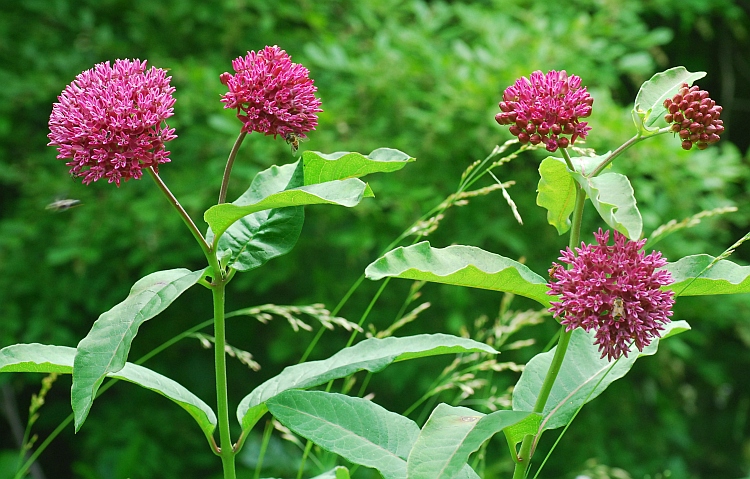Asclepias purpurascens L.
Purple Milkweed

Native
CC = 6
CW = 3
MOC = 75
© SRTurner
Asclepias purpurascens L.Purple Milkweed | |
 |
Native CC = 6 CW = 3 MOC = 75 |
© SRTurner |
|
Family - Asclepiadaceae Habit - Perennial forb from a taproot and deep rhizomes. Stems - Erect, to 1 m, unbranched or singly branched near the tip, densely hairy toward the tips, also with a vertical line of tomentoulose hairs decurrent from the base of each petiole, with 4-10 nodes.
Leaves - Opposite, decussate, simple, entire, short petiolate. Petioles to 1 cm long, antrorsely pubescent. Blades to 20 cm long, 10 cm broad, entire, lanceolate-elliptic or ovate, the base rounded, the tips abruptly acute, pubescent and deep green adaxially, light green and densely pubescent abaxially. Lateral venation anastomosing.
Inflorescence - Umbels, terminal and sometimes axillary from upper leaf nodes, 1-5 per stem, long-stalked, with 12-50 flowers. Peduncles to 7 cm long, erect, sparsely pubescent but wooly on one side. Pedicels to 2 cm long, wooly, subtended by linear bracts. Bracts withering quickly, to 6 mm long, pubescent.
Flowers - Calyx lobes 5, reflexed, sparsely to moderately short-hairy, surface, 2.5-4.0 mm long, lanceolate to ovate-lanceolate. Corolla lobes 5, reflexed, glabrous or minutely hairy on the inner surface toward the base, reddish purple to dark purple, 7-10 mm long, ovate to elliptic-lanceolate. Gynostegium appearing very short-stalked (the column barely visible below the bases of the hoods), pale purple (rarely tan and purple-tinged) to reddish purple, the corona conspicuously longer than the tip of the anther/stigma head. Corona hoods purplish pink, glabrous, 4-8 mm long, loosely ascending to ascending, attached near their bases, the apical portion oblong to ovate in outline, the tip narrowly rounded, the margins not noticeably lobed, the bases not pouched. Horns attached toward the hood bases, relatively short, bent or curved abruptly inward over the anther/stigma head and not extended past the tips of the hoods, sickle-shaped, relatively stout, slightly flattened, sharply pointed at the tip. Anther column white at the apex, 3-4 mm in diameter. Pollinia to 2 mm long, the connective deep purple. Pistils 2, glabrous, light green, 3 mm long in flower.
Fruits - Follicles 10-16 cm long, erect or ascending from deflexed stalks, narrowly elliptic to ovate and slightly arched in outline, the surface smooth, minutely hairy. Seeds with the body 5-7 mm long, the margins narrowly winged, the terminal tuft of hairs white.
Flowering - May - July. Habitat - Rocky open woods, glades, prairies, stream banks, wet meadows and valleys, thickets, roadsides. Origin - Native to the U.S. Lookalikes - Broadly, other milkweeds such as A. sullivantii. Other info. - This richly colored and showy species can be found throughout Missouri. It is most common in Midwestern states, though its range extends into New England and Canada. The flower color alone is generally sufficient for identification. The plant is quite striking and would grow with little care in a garden. This species also attracts many flying insects and would be a great addition to a butterfly garden. It seems to be a favored nectar source for the Great Spangled Fritillary butterfly (Speyeria cybele, see photo below). The plant has been known to hybridize with the common milkweed, A. syriaca.
Photographs taken off Hwy 21, Reynolds County, MO., 6-1-03, and off Hwy 106, Shannon County, MO., 6-12-04 (DETenaglia); also at Shaw Nature Reserve, Franklin County, MO, 5-29-2007 and 6-5-2015; Cuivre River State Park, Lincoln County, MO, 6-13-2009; Matson Hill County Park, St. Charles County, MO, 5-17-2012; and Weldon Spring Conservation Area, St. Charles County, MO, 6-8-2014 (SRTurner). |